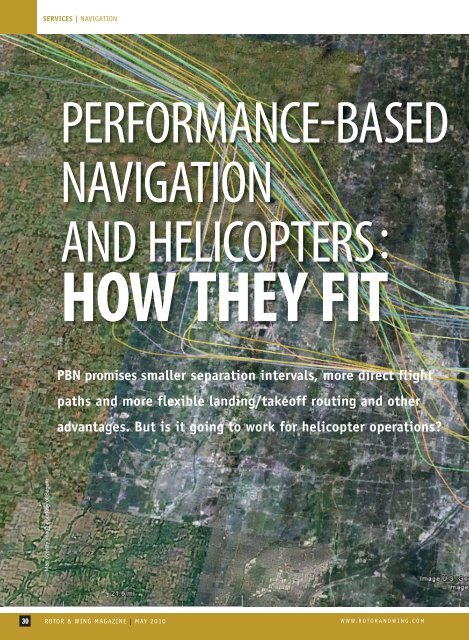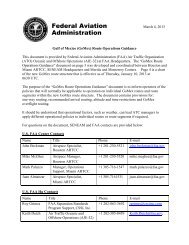PERFORMANCE BASED NAVIGATION AND HELICOPTERS : - ABAG
PERFORMANCE BASED NAVIGATION AND HELICOPTERS : - ABAG
PERFORMANCE BASED NAVIGATION AND HELICOPTERS : - ABAG
Create successful ePaper yourself
Turn your PDF publications into a flip-book with our unique Google optimized e-Paper software.
SERVICES | <strong>NAVIGATION</strong><br />
<strong>PERFORMANCE</strong>-<strong>BASED</strong><br />
<strong>NAVIGATION</strong><br />
<strong>AND</strong> <strong>HELICOPTERS</strong> :<br />
HOW THEY FIT<br />
PBN promises smaller separation intervals, more direct flight<br />
paths and more flexible landing/takeoff routing and other<br />
advantages. But is it going to work for helicopter operations<br />
Map overlay image courtesy of Sagem<br />
30 ROTOR & WING MAGAZINE | MAY 2010 W W W. R O T O R A N D W I N G . C O M
PBN Promise<br />
By James Careless<br />
Performance-based navigation (PBN) is a<br />
new form of aerial navigation currently<br />
being deployed by the FAA, ICAO and other<br />
aviation regulators worldwide. The reason is<br />
PBN supports smaller separation intervals, more direct<br />
flight paths and more flexible landing/takeoff routing<br />
for fixed-wing and rotary-wing aircraft alike. It does this<br />
using GPS and WAAS (wide area augmentation system)<br />
satellite signals, and advanced onboard navigation systems<br />
like the Garmin GNS-530W or Universal UNS-1FW.<br />
For helicopter pilots and operators, PBN offers many<br />
potential advantages. These include being able to develop<br />
helicopter-specific flight paths that avoid fixed-wing traffic;<br />
reducing time and fuel spent flying circuitous IFRbased<br />
patterns, and being able to fly more of the unique<br />
vertical approaches and departures that helicopters<br />
are suited for. This said, not everyone is convinced<br />
that PBN goes far enough in supporting optimal<br />
helicopter navigation.<br />
PBN Defined<br />
“At its simplest level, performance-based<br />
navigation gets down to the concept that<br />
the navigation system installed on each<br />
aircraft has its own standard of possible<br />
performance,” explains Chad Cundiff,<br />
Honeywell’s vice president of crew<br />
interface products. “PBN is designed to<br />
take advantage of these capabilities, by<br />
coming up with navigation rules that<br />
reflect this fact on a case-by-case basis.”<br />
For instance, a pilot f lying an<br />
AgustaWestland AW139 equipped<br />
with a Honeywell Primus Epic GPS/<br />
inertial system can fly within relatively<br />
tight flight and obstacle<br />
avoidance paths. But a pilot flying<br />
a helicopter with a less precise<br />
GPS-only system backed up by<br />
ground-based navigation beacons<br />
will have to leave more separation<br />
space.<br />
“In theory, an advanced PBN<br />
system would let you fly safely<br />
down a skyscraper canyon,<br />
by keeping you nicely positioned<br />
between the buildings<br />
on either side,”<br />
Cundiff notes.<br />
Why PBN<br />
Helicopters have the ability to take off vertically, level off at an<br />
appropriate altitude (i.e., avoiding cool moist air where icing<br />
can be a danger), and land vertically as they please.<br />
In a perfect world, helicopter pilots would be able to use<br />
this ability to its fullest. However, in reality the rules of aerial<br />
navigation have been dictated by the needs of fixed-wing<br />
aircraft. If helicopters are powerboats, fixed-wing aircraft are<br />
lumbering oil tankers. They need lots of space to takeoff, fly<br />
and land without hitting each other. This is why the world’s<br />
air corridors are so tightly monitored and why the growing<br />
amount of fixed-wing traffic within these corridors has<br />
regulators so concerned. It is this concern that has pushed the<br />
FAA and other regulators into implementing PBN.<br />
With PBN technology, aircraft fly closer together and<br />
employ more creative, three-dimensional takeoff and landing<br />
approaches.<br />
PBN’s capabilities are good news for the FAA, which is<br />
grappling with the relentless growth of air travel. “In 2005,<br />
passenger demand grew rapidly, with enplanements up 7<br />
percent from the previous year to 738.6 million and revenue<br />
passenger miles increasing 8 percent to 775.3 billion,” says<br />
the 2006 version of the FAA’s Roadmap for Performance-<br />
Based Navigation. “Passenger demand for air transportation<br />
is projected to increase an average of 3.4 percent each year<br />
between 2005 and 2017. By 2017, U.S. commercial air carriers<br />
are predicted to transport a total of about one billion passengers,<br />
flying over 1.25 trillion passenger miles.”<br />
The FAA is currently deploying advanced PBN systems<br />
at the country’s airports, and establishing PBN air corridors<br />
to serve busy air routes. The goal is to convert U.S. general<br />
aviation to PBN operation by 2025. Other countries are following<br />
suit.<br />
“We want to extend PBN to helicopters, such that helicopters<br />
get their own air corridors where possible; have less<br />
interaction with air traffic control simply because they spend<br />
less time in fixed-wing airspace; and have easy access to heliports<br />
and other designated landing areas,” says Mike Webb, of<br />
the FAA’s AFS-420 Flight Procedure Standards Branch. He is<br />
currently developing PBN-compliant helicopter instrument<br />
procedures. “With the help of highly accurate GPS/WAAS<br />
satellite signals and onboard navigation systems, helicopter<br />
pilots will be able to use much more of their aircraft’s maneuverability<br />
in obstacle-rich urban environments.”<br />
“Our goal is to move helicopter navigation away from its<br />
fixed-wing roots,” adds Erwin Lassooji, ICAO’s PBN program<br />
manager. “We are currently developing helicopter-specific<br />
PBN standards for all phases of flight, not just approach and<br />
takeoff. We anticipate updating these standards officially by<br />
March 2011.”<br />
W W W. R O T O R A N D W I N G . C O M<br />
MAY 2010 | ROTOR & WING MAGAZINE<br />
31
SERVICES | <strong>NAVIGATION</strong><br />
Honeywell<br />
Performance-based navigation will allow helicopter pilots to use their aircraft’s avionics capabilities more, especially when approaching airports. It will<br />
allow pilots to come up with new and more relevant approaches that better meet their company’s needs. This can translate into less fuel burn and savings.<br />
PBN Helo Advantages<br />
Performance-based navigation will allow<br />
helicopter pilots to use their aircraft’s avionics<br />
capabilities more, especially when<br />
approaching airports. Like their fixedwing<br />
cousins, such helicopters will be<br />
allowed to fly tighter, closer and more<br />
varied approaches, using curves and even<br />
spirals where such approaches make sense.<br />
This flexibility translates into less fuel<br />
burned and less time aloft, thus increasing<br />
the number of flights a helicopter can<br />
make before being grounded for regular<br />
maintenance. But PBN does more than<br />
just save money. It allows pilots to come up<br />
with new and more relevant approaches<br />
that better meet company needs.<br />
“With PBN, you can work out fuel-efficient<br />
approaches to heliports, hospitals and<br />
other regular landing sites that stay clear of<br />
fixed-wing traffic,” Cundiff says. “This<br />
means that you can count on being cleared<br />
by local air traffic control, even when fixedwing<br />
traffic is heavy in your area.”<br />
PBN also offers improved, more precise<br />
IFR flight for helicopters. For some<br />
pilots, this will change the point at which<br />
to decide to go from VFR to IFR; simply<br />
because going to instruments won’t necessarily<br />
mean submitting to air traffic control<br />
and its delays, holding patterns and circuitous<br />
routes.<br />
Dissent<br />
Compared to the old radio beacons that<br />
it replaces, PBN is a real advance for helicopter<br />
aviation. But Stephen Hickok does<br />
not think PBN goes far enough. In fact, he<br />
believes that the FAA doesn’t really understand<br />
rotary-wing flight, and that its ‘NextGen’<br />
air traffic strategy is far too tied to<br />
traditional fixed-wing thinking. “The FAA’s<br />
PBN strategy is built upon a ‘one-size-fitsall’<br />
approach that does not truly recognize<br />
the unique capabilities and needs of helicopters,”<br />
Hickok tells Rotor & Wing. “It is<br />
designed for aircraft that rely on runways,<br />
and helicopters don’t need runways. If anything,<br />
our runway is the sky.”<br />
Hickok has the credentials to stand as a<br />
credible critic. He is president of Hickok &<br />
Associates of Orange Beach, Ala., a company<br />
that designs airspace and instrument<br />
approach procedures. According to his<br />
website (www.hickokgpsifr.com), Hickok<br />
managed the FAA’s helicopter GPS flight<br />
testing, “which led to the origination of<br />
the very policies and criteria used for the<br />
development of today’s IFR procedures.”<br />
Hickok has served as an ICAO advisor, and<br />
has been both chairman of HAI’s Flight<br />
Operations Committee, and chairman of<br />
the Vertical Flight Working Group to FAA’s<br />
Performance-Based Aviation Rulemaking<br />
Committee.<br />
If that’s not enough credibility, consider<br />
this: On April 1, 2009, the FAA approved<br />
the first helicopter WAAS Localizer Performance<br />
with Vertical Guidance (LPV)<br />
Instrument Flight Procedures (IFPs).<br />
Hickok’s company developed this first<br />
IFP—actually three IFPs—for California<br />
Shock/Trauma Air Rescue (CALSTAR).<br />
When it comes to PBN, Hickok’s concern<br />
about the FAA is that “they are still in<br />
a fixed-wing mindset.” As such, the FAA’s<br />
PBN rules do not allow pilots “to use our<br />
helicopters and their avionics to their fullest<br />
advantage,” he says.<br />
From Hickok’s perspective, the FAA’s<br />
PBN rules group high-capability helicopters<br />
together with their lower-performing<br />
counterparts, with the limits on missed<br />
approaches and other elements being<br />
32 ROTOR & WING MAGAZINE | MAY 2010 W W W. R O T O R A N D W I N G . C O M
PBN Promise<br />
Sagem’s analysis ground station software allows<br />
for the recreation of flight trajectories. These<br />
trajectories can then be examined and PBN<br />
approaches, departures and flight planning can<br />
be developed.<br />
set to the lowest common denominator.<br />
“We need to do better than just reverseengineering<br />
fixed-wing criteria,” Hickok<br />
observes. “We need helicopter-specific<br />
PBN, that matches a range of helicopter<br />
capabilities.”<br />
Bell’s PBN Research<br />
Despite his criticism, Hickok is aiding<br />
the FAA in adapting PBN for helicopters,<br />
specifically by helping Bell Helicopter with<br />
its PBN research. Specifically, the FAA<br />
has contracted Bell to collect PBN-related<br />
measurements using a Bell 429 equipped<br />
with WAAS-enabled Garmin GNS 430W<br />
and GNS 530W avionics units (one each).<br />
“Steve Hickok developed the profiles<br />
that we are using to collect PBN approach<br />
data,” says David Downey, Bell’s vice president<br />
of flight operations/safety and certification.<br />
“Our goal is to create a series of<br />
operating procedures ranging from pointin-space<br />
to landing and departure.”<br />
The Bell 429 is a single-pilot IFR helicopter,<br />
making it an ideal testbed for EMSfocused<br />
PBN procedures. “70 percent of all<br />
EMS flight are hospital-to-hospital,” says<br />
Downey. “Imagine that you could go to<br />
work by getting in your car, pushing a button,<br />
and having your car execute the necessary<br />
turns and speeds. An EMS-based<br />
PBN solution could do that for hospital-tohospital<br />
transfers.<br />
Not only would this make flights safe<br />
in all weather conditions, but air traffic<br />
control would always know where the<br />
EMS helicopters were, simply because they<br />
would be following this predefined flight<br />
profile. That’s the kind of things we are<br />
working on for the FAA.”<br />
Preparing for PBN<br />
For helicopter pilots and operators, trying<br />
to decide where PBN fits into your operation<br />
can be confusing.<br />
The best place to start is by looking<br />
over your avionics equipment to see just<br />
what capabilities it does and does not support.<br />
Such evaluations are a key part of the<br />
PBN approach: The FAA recognizes that<br />
not every aircraft is PBN-capable, let alone<br />
compliant.<br />
Should you find your current avionics<br />
lacking, then now is the time “to start<br />
imaging the fuel/maintenance savings<br />
and enhanced safety you could achieve<br />
by upgrading your avionics suite,” Honeywell’s<br />
Cundiff says. For instance, his company’s<br />
Primus Epic couples GPS/WAAS<br />
with an onboard inertial guidance system;<br />
providing key redundancy if something<br />
(i.e., strong solar flares) should knock out<br />
GPS/WAAS satellite signals. It makes<br />
your helicopter truly PBN-capable.<br />
Sagem Avionics also supports helicopter/PBN<br />
deployments. “To enable<br />
performance-based navigation, operators<br />
must collect data and perform routine<br />
analysis of this data to design [their] PBN,”<br />
explains company spokesperson Emmy<br />
Ansinelli. “Sagem’s AGS (Analysis Ground<br />
Station) software allows for the recreation<br />
of trajectories. These trajectories are then<br />
examined and PBN approaches, departures<br />
and flight planning can be developed<br />
for each aircraft type within the operator’s<br />
organization.”<br />
“The aim of performance-based navigation<br />
is primarily to reduce risks and<br />
costs [i.e., fuel burn] to the operator,”<br />
Ansinelli adds. “To make sure that PBN<br />
implementation is successful, Sagem’s<br />
AGS can be used to continuously perform<br />
post flight routine analysis. As the flight<br />
data is analyzed, the operators can measure<br />
the PBN’s efficacy; for example, is the<br />
aircraft burning less fuel”<br />
Final Verdicts<br />
Performance-based navigation is undeniably<br />
the way of the future. In the years<br />
to come, helicopter pilots will be able<br />
to fly more precise, shorter and tighter<br />
approaches to their targets, with the added<br />
benefit of spending more time outside of<br />
air traffic controlled airspace.<br />
Will this aid speciality operators, such<br />
as EMS single pilots flying IFR approaches<br />
“I don’t really think anybody knows,” replies<br />
Hickok. “PBN is primarily concerned<br />
with the space around airports, which is<br />
not where EMS pilots make most of their<br />
approaches.”<br />
Dave Downey is more optimistic. “We<br />
believe that, by contracting Bell to do PBN<br />
research, the FAA is saying, ‘we probably<br />
didn’t pay as much attention as we should<br />
have to rotary-wing when we came up<br />
with PBN initially, and now we want to<br />
fix that,’” he says. “Frankly, I think we have<br />
a tremendous opportunity to prove how<br />
well helicopter-based PBN can complement<br />
what’s being put in place for fixedwing.”<br />
Wherever they stand, all helicopter<br />
pilots and operators would be well-advised<br />
to learn more about PBN through the<br />
FAA (www.faa.gov/news/fact_sheets/<br />
news_story.cfmnewsId=8768) and ICAO<br />
(www2.icao.int/en/pbn/Pages/default.<br />
aspx). Love it or not, PBN is coming!<br />
Map overlay image courtesy of Sagem<br />
W W W. R O T O R A N D W I N G . C O M<br />
MAY 2010 | ROTOR & WING MAGAZINE<br />
33









